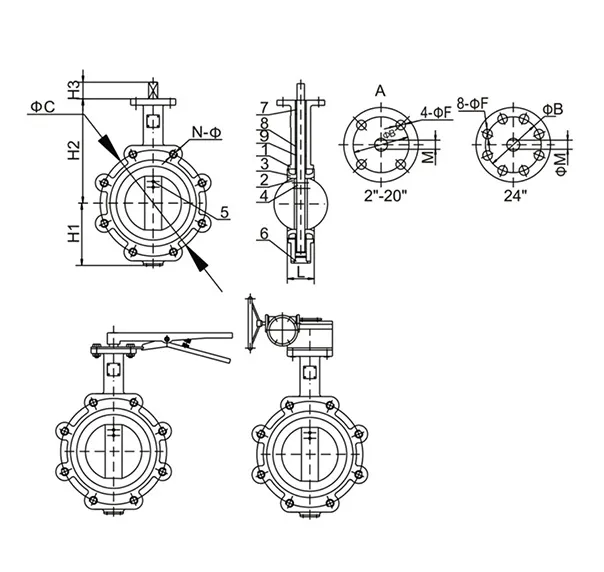Nov . 27, 2024 07:02 Back to list
Industrial Ball Valve Applications and Benefits in Modern Industries
Understanding Industrial Ball Valves A Comprehensive Overview
Industrial ball valves are crucial components in various industrial processes, serving as a reliable means to control the flow of liquids and gases. These valves employ a spherical disc, known as a ball, which features a hole (or port) through its center. The design allows for quick and efficient shut-off as well as control of flow direction. This article will delve into the features, types, advantages, and applications of industrial ball valves, providing a comprehensive understanding of their significance in modern industries.
The Design and Functionality of Ball Valves
At the heart of a ball valve's function is its ball element. In a typical open position, the hole in the ball aligns with the pipeline, allowing fluid to pass through. When the valve is closed, the ball rotates 90 degrees, blocking the flow. This simple yet effective mechanism not only enables quick operation but also minimizes pressure drops across the valve. Ball valves can be operated manually using a lever or through automated systems that employ electric or pneumatic actuators, which allow for remote control and integration into automated systems.
Types of Industrial Ball Valves
There are several variations of industrial ball valves, each designed for specific applications and operational needs. The most common types include
1. Floating Ball Valves In this design, the ball is not fixed in place and floats within the seats. The pressure of the fluid pushes the ball against the downstream seat, providing a tight seal. These valves are commonly used in lower-pressure applications.
2. Trunnion Ball Valves Unlike floating ball valves, trunnion valves have a fixed ball supported by trunnions (supporting shafts). This design allows them to handle higher pressures and larger diameters, making them suitable for critical applications in oil and gas and power generation sectors.
3. V-Port Ball Valves These valves have a V-shaped notch in the ball, allowing for precise flow control and regulation. They are ideal for applications requiring throttling abilities.
4. Multi-port Ball Valves These valves feature more than two ports, allowing for flow diversion or mixing in a single valve. They are particularly useful in systems where multiple pathways or configurations are needed.
Advantages of Industrial Ball Valves
The popularity of ball valves in industrial applications can be attributed to several key advantages
industrial ball valve

- Quick Operation Ball valves can be opened or closed with only a 90-degree rotation, which makes them ideal for applications requiring rapid operation. - Durability They are constructed from robust materials such as stainless steel, brass, or plastic, and can withstand harsh conditions, including high pressures and temperatures.
- Low Maintenance With fewer moving parts compared to other valve types, ball valves require less maintenance and have a longer service life
.- Tight Seal The design of ball valves ensures minimal leakage when closed, providing a reliable seal even under high-pressure conditions.
Applications of Industrial Ball Valves
Industrial ball valves are versatile and find applications across various industries, including
- Oil and Gas Used for flow control and isolation in pipelines, refineries, and processing plants.
- Chemical Processing Vital for managing the flow of corrosive fluids and chemicals safely.
- Water and Wastewater Management Employed in treatment plants for controlling water flow and isolation during maintenance.
- Power Generation Used in steam, cooling, and fuel systems to regulate flow and pressure.
- Food and Beverage Essential for maintaining cleanliness and controlling flow within processing applications.
Conclusion
In summary, industrial ball valves represent a vital aspect of fluid control systems across numerous industries. Their robust design, quick operation, and reliability make them an indispensable choice for engineers and operators alike. Understanding the different types of ball valves, their advantages, and their applications can lead to better decision-making when selecting the right valve for specific industrial needs. As industries continue to evolve, the ball valve's role in ensuring efficient and safe operation will undoubtedly remain significant.
Share
-
Reliable Wafer Type Butterfly Valves for Every IndustryNewsJul.25,2025
-
Reliable Flow Control Begins with the Right Ball Check ValveNewsJul.25,2025
-
Precision Flow Control Starts with Quality ValvesNewsJul.25,2025
-
Industrial Flow Control ReliabilityNewsJul.25,2025
-
Engineered for Efficiency Gate Valves That Power Industrial PerformanceNewsJul.25,2025
-
Empowering Infrastructure Through Quality ManufacturingNewsJul.25,2025